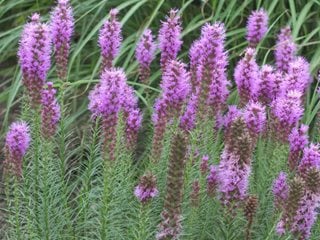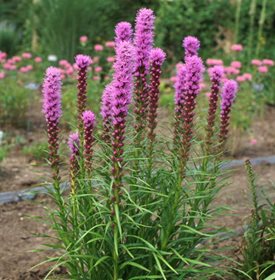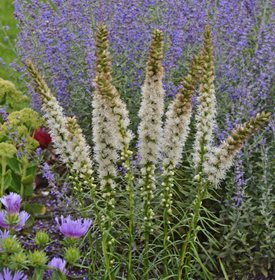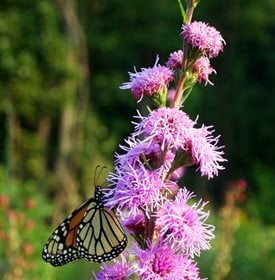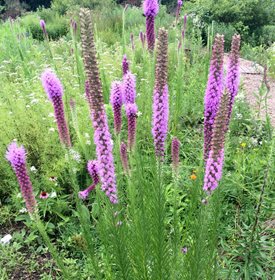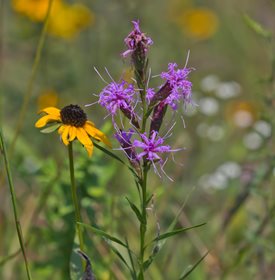How to Grow and Care for Liatris
Set your summer garden ablaze with an explosion of color with easy-care native blazing star flowersIncluded in our list of top perennials for a butterfly garden, blazing star (Liatris) is prized for its ability to attract all sorts of pollinating insects, especially monarchs, swallowtails, and other butterflies. In addition to its value to the ecosystem, this sun-loving wildflower also brings striking vertical form to the ornamental garden, sending up tall spires of vibrant rose-purple blooms during the dog days of summer, when most spring-flowering perennials are past their peak. And like many native plants, blazing stars are nearly invincible.
“Heat like you get in Houston, cold like you get in Minnesota, poor soil that won’t support a crop of weeds, and drought that leaves other plants gasping for water—nothing bothers this sturdy native American,” says Jeff Cox, author of Perennial All-Stars, a guide to some of the best plants for trouble-free gardens.
On this page: The Basics | Planting | Care | Pictures | Liatris In Your Garden
THE BASICS
Botanical name:
Liatris
Common names:
Blazing star, gayfeather (because of its feathery flower plumes)
Plant type:
Herbaceous perennial
Zones:
3-9
Height:
1 to 5 feet, depending on the species
Exposure:
Grows best in full sun, but will tolerate light shade. (See more full-sun perennials.)
Bloom Time:
Mid to late summer
Color and characteristics:
Produces fuzzy florets of bright purple or white flowers that bloom from the top down on unbranched stems, giving them a unique bottlebrush effect. The slender, grass-like green foliage stays attractive all summer and deepens to bronze in the fall.
Varieties:
There are about 40 species of liatris, most native to the prairies and meadows of eastern and central North America. All are very similar in culture and growth habit, so pick plants that suit your preference of height and flower color.
PLANTING
What to plant:
You can grow blazing star from corms, seeds, potted nursery-grown plants or bare-root plants. Seeds and corms are the most economical choices, but you’ll need patience when planting seeds because it often takes a year or two before they produce blooms. When buying corms, pay attention to the size. Larger corms (at least 3 inches in diameter) will produce the most robust flowers.
When to plant:
Plant corms or tuberous roots in spring. Flowers usually appear 70 to 90 days after planting. Sow seeds directly outdoors in fall or early spring, or start them indoors in late winter 6 to 8 weeks before the last frost date.
Soil:
Like most prairie plants, blazing star isn’t choosy about soil conditions and may grow too tall and flop over in soil that is overly fertile. The one essential is good drainage, especially in winter. The roots can rot if allowed to sit in wet soil.
Spacing:
To permit good air circulation, space plants at least a foot apart. Because of its strong vertical presence, blazing star looks best when planted in groupings of six or more rather than in row formation (unless they are part of a cutting garden).
CARE
Watering:
Water new plantings weekly in dry weather until a strong root system is established. Once plants have matured, they will tolerate dry spells because the corms naturally retain water. However, if you experience prolonged periods of drought during the heat of the summer, give your plants about an inch of water a week to keep them hydrated.
Maintenance:
Because blazing star blooms from the top down, you can pinch back the spent blossoms to prolong its beauty. After plants have finished blooming, the flower stalks can be cut back to their grassy basal leaves, or you can leave the stalks and seedheads in place until spring to provide vertical interest throughout the winter and a food source for local and migrating birds.
Dividing:
Divide clumps every few years, or as needed to prevent overcrowding. Dig up the plants in spring and cut the tuberous roots into sections with a sharp knife, making sure each section has one “eye” or bud. Plants will also readily self-sow if you don’t cut the flower stalks back in the fall.
Diseases and Pests:
Blazing stars are rarely troubled by insects or diseases, but the foliage can succumb to powdery mildew, especially in hot, humid weather. The problem can minimized by growing plants in full sun and providing ample space between them to improve air circulation.
PICTURES
LIATRIS IN YOUR GARDEN
- Wildflower or meadow gardens, butterfly gardens, water-wise landscapes, cottage gardens, and at the back of beds and borders.
- Use smaller, dwarf varieties in window boxes, along edging, and in containers.
- Because of its vertical form, blazing star takes up minimal space and is easy to tuck into smaller gardens.
- In larger beds, plant in drifts to create the greatest visual impact.
- Be sure to plant extra for cutting to provide vertical interest in fresh or dried flower arrangements.
RELATED:
21 Easiest Flowers for Beginners
21 Low-Maintenance Plants
The 24 Best Plants to Attract Hummingbirds
